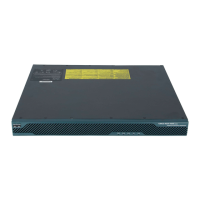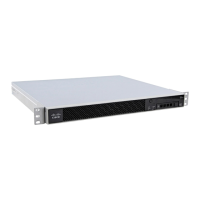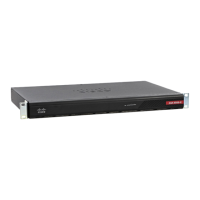1-14
Cisco ASA Series CLI Configuration Guide
Chapter 1 Information About NAT
How NAT is Implemented
–
Network object NAT— Each rule can apply to either the source or destination of a packet. So
two rules might be used, one for the source IP address, and one for the destination IP address.
These two rules cannot be tied together to enforce a specific translation for a source/destination
combination.
–
Twice NAT—A single rule translates both the source and destination. A matching packet only
matches the one rule, and further rules are not checked. Even if you do not configure the
optional destination address for twice NAT, a matching packet still only matches one twice NAT
rule. The source and destination are tied together, so you can enforce different translations
depending on the source/destination combination. For example, sourceA/destinationA can have
a different translation than sourceA/destinationB.
• Order of NAT Rules.
–
Network object NAT—Automatically ordered in the NAT table.
–
Twice NAT—Manually ordered in the NAT table (before or after network object NAT rules).
See the “NAT Rule Order” section on page 1-18 for more information.
We recommend using network object NAT unless you need the extra features that twice NAT provides.
Network object NAT is easier to configure, and might be more reliable for applications such as Voice
over IP (VoIP). (For VoIP, because twice NAT is applicable only between two objects, you might see a
failure in the translation of indirect addresses that do not belong to either of the objects.)
Information About Network Object NAT
All NAT rules that are configured as a parameter of a network object are considered to be network object
NAT rules. Network object NAT is a quick and easy way to configure NAT for a network object, which
can be a single IP address, a range of addresses, or a subnet.
After you configure the network object, you can then identify the mapped address for that object, either
as an inline address or as another network object or network object group.
When a packet enters the ASA, both the source and destination IP addresses are checked against the
network object NAT rules. The source and destination address in the packet can be translated by separate
rules if separate matches are made. These rules are not tied to each other; different combinations of rules
can be used depending on the traffic.
Because the rules are never paired, you cannot specify that sourceA/destinationA should have a different
translation than sourceA/destinationB. Use twice NAT for that kind of functionality (twice NAT lets you
identify the source and destination address in a single rule).
To start configuring network object NAT, see Chapter 33, “Configuring Network Object NAT.”
Information About Twice NAT
Twice NAT lets you identify both the source and destination address in a single rule. Specifying both the
source and destination addresses lets you specify that sourceA/destinationA can have a different
translation than sourceA/destinationB.
The destination address is optional. If you specify the destination address, you can either map it to itself
(identity NAT), or you can map it to a different address. The destination mapping is always a static
mapping.
Twice NAT also lets you use service objects for static NAT with port translation; network object NAT
only accepts inline definition.

